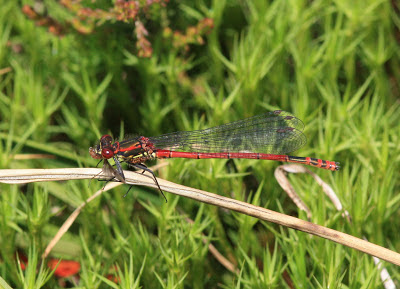It's been a strange week. Not just because it rained.
Regular readers of this blog (come on, own up, one of you must qualify) may recall a certain cast member of the small band of characters who occasionally inhabit these pages. I am referring to the one and only Captain Sundial. See here, here and here, if you need reminding.
This Thursday, 25th July 2013, marked his last working day, as he retired this week, just a few days shy of his 75th birthday.
By way of a tribute/wind-up/celebration of the good times, as well as cards and leaving pressies, he was given a document, highlighting some of the moments for which we will remember him with great fondness.
The History of the
World, Part 1 of 1, from the beginning of time until the present
(In which we discuss the nature of causality and the
temporal effects of entropy)
In the beginning, God created
the transmitter and the receiver.
But the picture was without
form, and void; and a small voice said, "Have you powered up the
transmitter? We're only seeing white noise at this end."
And then darkness was upon the
face of the screen, so the small voice said encouragingly, "That's better,
but you might want to switch on the camera too, 'cos we're just receiving a
carrier now."
And God said, Let there be
light: and there was light.
And the small voice, the nascent
Spirit of Radio, saw the light, that it was good: and said, "That's a
really neat trick."
Approximately 4.5 billion
years later, or a little after 4005BC depending upon your point of view, an
infant Captain Sundial cast his first shadow and everyone agreed that it was lovely,
but wouldn’t it be a good idea if we put his nappy back on now, please?
Following a childhood
filled with more ordnance than you could shake a Trident missile at, possibly
due to some international fisticuffs and an arsey bloke with a moustache, CS took to National Service like a duck to atomic physics. His contempt for
authority, and blatant use of a self-loading instinct to deliberately take the
opposing viewpoint to any given order, saw him banished to the Library where it
was thought he could do little harm... teaching officers which way was up and
other life skills.
Years passed,
civilisations came and went (as did one or two electronics companies) and with
much heralding, and not a little mickey-taking on the subject of sundials,
CS arrived at his current place of work in 2002.
His avowed intent was
to fly the flag for analogue technology, but within an hour of arriving, he’d
discovered a sundial on the gable end of the Post Office next door. Oh how we
laughed, and then looked sheepishly at each other, thinking "How the hell had we
missed that?"
CS settled into
life amongst several colleagues who he had known for many a year. He’d
watched them grow up from wet-behind-the-ears graduates and develop into
fully-fledged electronics design engineers (or at least ones with the ability
to use a photocopier), whilst in turn, they all thought he was... just the same
old codger he’d always been.
Those of us who have
had the pleasant fortune to work with CS at other firms are well-versed in
his little eccentricities. But anyone new to the company who hadn’t encountered the
Gospels according to CS tended to spend a few hours, or days, in shock,
until taken to one side by some kind-hearted soul and re-assured that “It’s ok,
he does talk to his sandwiches. You only need to worry if you can hear
them talking back.”
I count myself amongst
that happy band of co-workers that have known CS for some considerable time.
He has occupied the neighbouring bench through the best years of my working
life. This is no coincidence. With more experience than can reasonably be
crammed into one lifetime, CS has taught me so much, not only about
electronics and RF, but also a wide variety of other topics, such as
astro-archaeology, paganism, ancient civilisations, combat pedantry and, of course, sundials.
It must be
acknowledged that CS has been at his most tolerant of authority and
administration during these past eleven years. Yes, really! Whether this indicates a softening of his
principles over time or perhaps a begrudging acceptance of the tide of
officialdom, it is impossible to gauge. Or maybe, to think the unthinkable, he
actually likes working here! However, not a day has gone by when he hasn’t
asked, “Can I go home now?” The timing of this request varies depending upon
whether the electronics are fighting back or if he’s had enough of bureaucracy,
but his personal best is an impressive 9.06am.
With typical topical timing, this week, the question morphed into "Can I retire now?"
I accidentally
discovered that the only sure-fire way to wind him up was to wear a tie. This,
in part, explains why I rarely do!
CS has been an
absolute joy to work alongside and he will be hugely missed. His knowledge and
experience, coupled with his willingness to share this information for the
betterment of all, mark him out as a test engineer par excellence. If there is
a Spirit of Radio, he embodies it heart and soul.
In saying farewell to
Captain Sundial and wishing him every happiness in his well-deserved retirement, I would
like to share with you a few examples of the many vocational courses and
training sessions that he has attended over the years.
 |
| 1998 Food Handling course |
CS: "These sandwiches are awful!"
Tense: "Who made them?"
CS: "I did."
 |
| 1999 Ethnicity and Diversity training |
"Let the wind blow high, let the wind blow low. Through the streets in a kilt I'll go.
All the lassies shout "Hello! CS where's your troosers?"
 |
2006 Working Time (Lord) Directive seminar
|
.jpg)
.jpg)













.jpg)





.JPG)

.jpg)






.jpg)




















